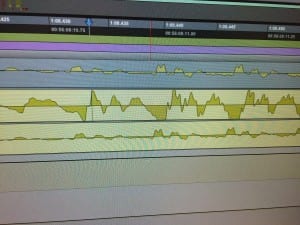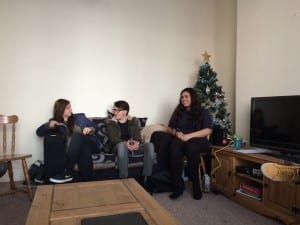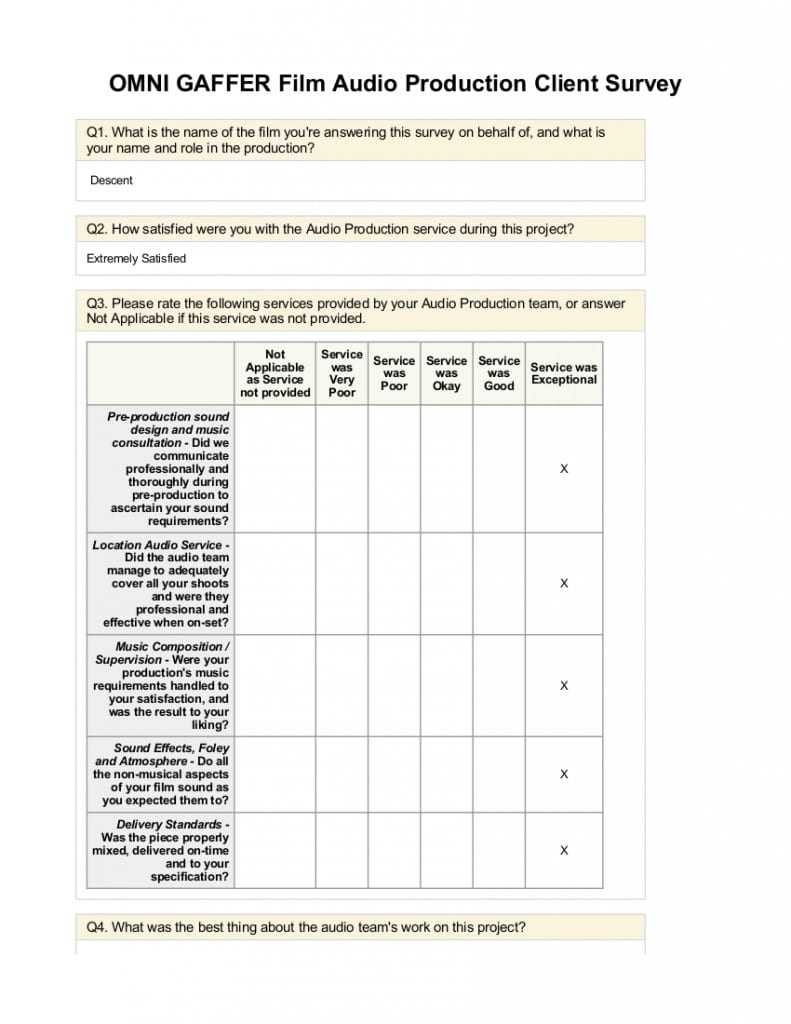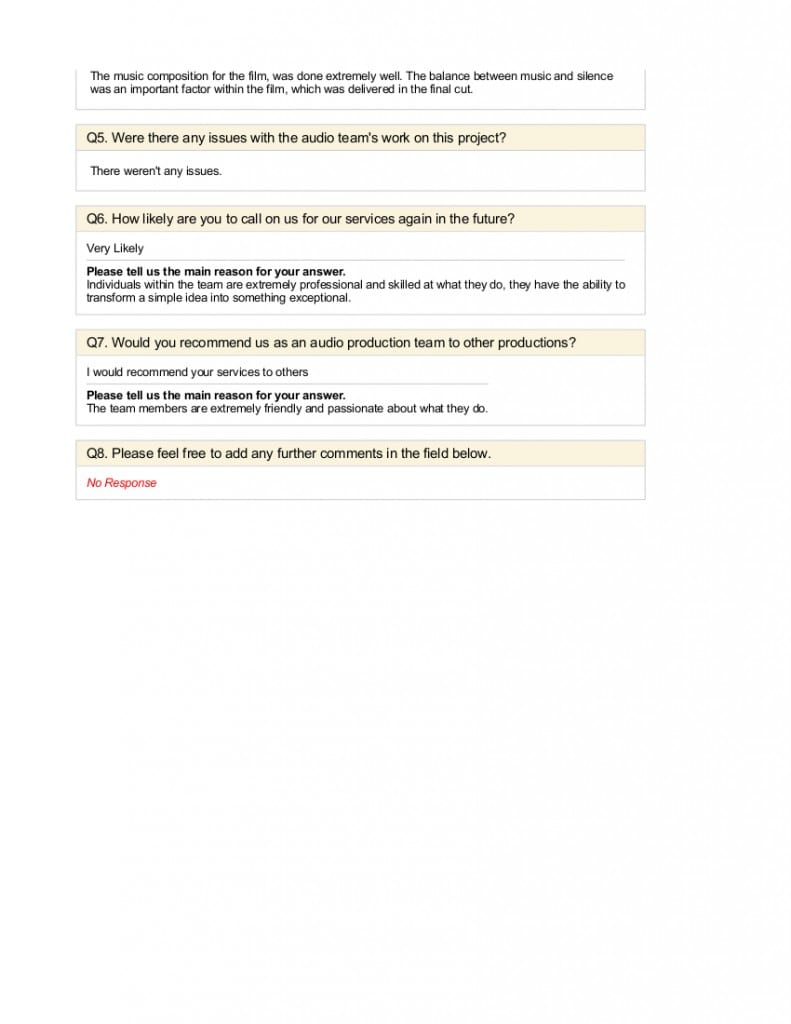(Outcomes – GR 1,2,3,4,5 + IN1 + PER4)
Having completed the final mix of Descent, this post will comprise an appraisal of issues with the artifact as it stands.
The main issue was with dialogue during editing and premix, with the close shot scenes around the kitchen table particularly problematic as the room they took place in has the most horrendous honky reverb which acted like the classic tiled bathroom reverb on all the dialogue, worsening as the actor’s projected more. This reverb was largely removed with Izotope RX, and some EQ’s applied to the dialogue at the same time. However, the dialogue takes were presumably not tested together prior to the mix phase (dialogue edit and mix were carried out by two different people), where it was discovered that any dialogue which is both boomed and collected from a radio mic on the same actor is close to 180 degrees out of phase, obviously closer to this amount relative to the shot, as the boom was able to be placed closer to the actor.

You can clearly see the reversed phase in the photograph above. I can surmise that the outputs on the university radio mics and the MKH boom microphones are wired to opposite polarities, and this wouldn’t have been noticed on set because the master mix I use when monitoring the incoming audio was always split into stereo, with one side comprising radio mics and the other comprising the boom and other mics. When these were mixed together in the scenes however, noticable phase cancellation occurs. The combination of this and the processing in RX left the dialogue lacking body, and dangerously thin in places, whilst attempts to correct this using channel EQ consumed a large amount of time in mix. This finally necessitated the recutting of the main dialogue-heavy kitchen scenes after the first pass mix had been completed as we collectively felt it simply wasn’t up to standard, and the dialogue is still not perfect in the finished version. [GR3,5,IN1]
The mixture of production audio and foley is also a fine art and Descent uses a lot of audio from the set for the busier scenes. It was not always possible to perfectly match the perspectives of the actual set with the sounds we created in foley, and the artificial reverbs and different room tones are occasionally noticeable.
Moving on to the effects of our collaboration on the production of Descent, this particular film was very much a group effort. The script and planning phase benefited from a great deal of input from other team members, I had the choice of two composers for the project and was able to go with the one whose approach best suited the director. In post, both foley and dialogue editing tasks were split to other group members, and the final mix was heavily collectively appraised, overruling my preference and leading to an 11th hour dialogue remix which improved the issues described above. This film would definitely have been worse without the group approach, and my own time would have been less efficiently spent for certain. [GR1, PER4]
In terms of feedback on the production, I sent the following to the director and producer:
“The core team for Descent were exceptional, transcending the standard of many of the student productions with which I’ve become acquainted this year. All communication was prompt, consistent and professionally managed, production plans and details were communicated with plenty of time, and included opportunities for audio recces of the set and a sensible regime of pre-production meetings and test shoots. The production team engaged early with the process of designing the audio dimension of the film and were creative and professional in the way ideas and plans were formed, communicated and allowed to evolve.
On set, the extended production team worked cohesively and largely to a strict schedule with little apparent stress or evidence of issues. Location audio work was a pleasure to manage from my perspective. I strongly recommend any member of the team for roles in future productions and would be pleased to find myself working alongside any of them again in the future.”
In turn, we received glowing feedback from them for the service, which can be viewed in it’s entirety here. [GR1,3,4,5 + IN1 + PER4]
At 17 and a half minutes, the piece is reasonably long for a short student film created in a single term, and I’m proud of managing to sustain the work of carrying this film’s audio through from inception to completion. Whilst it still has a couple of rough edges, I believe it stands up as the first piece of film audio work worthy of portfolio use. One major piece of practical information I have learned from my work here is always monitor and mix your location in mono. The film editors who receive the raw audio before sending back the compiled lists do not benefit from stereo, and monoing at either point would have allowed me to pick up the phase issues on-set and saved time in post. [GR3]
——— 740 Words
KEY POINTS –
Discussion of some issues in the final mix of Descent – Individual Reflection
- [GR3] To provide a professional standard of service in respect to location sound recording and post-sound design / mixing.
- [GR5] To produce soundtracks comprising of foley, SFX, dialogue, music and atmospheres to client specifications that synergistically support the other components of their films.
- [PER4] To contribute extensively to multiple film productions.
Group involvement in the production of Descent – Process Management
- [GR1] To professionally operate as a small to medium size company (or other recognisable business entity) in the audio production / post-production field might.
- [PER4] To contribute extensively to multiple film productions.
Feedback between groups – Professional Practice
- [GR1] To professionally operate as a small to medium size company (or other recognisable business entity) in the audio production / post-production field might.
- [GR3] To provide a professional standard of service in respect to location sound recording and post-sound design / mixing.
- [GR5] To produce soundtracks comprising of foley, SFX, dialogue, music and atmospheres to client specifications that synergistically support the other components of their films.
- [GR4] To conceive, compose, source and / or produce music to client specifications that synergistically supports the other components of their films.
- [IN1] To successfully manage the provision of service by the business for the film Descent with regard the assignment of resources, specialisms and working time, liason with the director, editor and producer on a practical and creative level, and communication of information on their needs and requirements for the piece, in order to appraise the efficacy of the collaborative approach to working on the piece – (Supervisor and Company Officer)
Reflection on process and learning – Individual Reflection
- [GR3] To provide a professional standard of service in respect to location sound recording and post-sound design / mixing.


